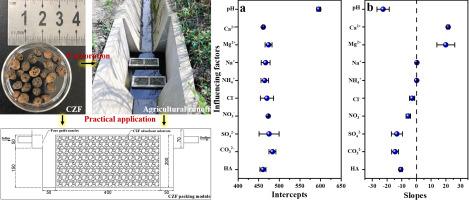当前位置:
X-MOL 学术
›
Ecol. Eng.
›
论文详情
Our official English website, www.x-mol.net, welcomes your
feedback! (Note: you will need to create a separate account there.)
Performance of a new low-cost Zn/Fe-layered double hydroxide-modified ceramsite for the removal of P from agricultural runoff
Ecological Engineering ( IF 3.9 ) Pub Date : 2021-01-01 , DOI: 10.1016/j.ecoleng.2020.106117 Feng Liu , Xinqiang Liang , Shuang He , Fayong Li , Yingbing Jin , Ziyi Zhao , Liang Zhu
Ecological Engineering ( IF 3.9 ) Pub Date : 2021-01-01 , DOI: 10.1016/j.ecoleng.2020.106117 Feng Liu , Xinqiang Liang , Shuang He , Fayong Li , Yingbing Jin , Ziyi Zhao , Liang Zhu

|
Abstract Modified ceramsite has been widely reported as a P adsorbent in wastewater treatments; however, its performance in removing P from agricultural runoff is unclear. A new low-cost ceramsite is modified in this study applying Zn/Fe-layered double hydroxides (LDHs; CZF) to investigate its practicality in treating P-polluted agricultural runoff. The results revealed that the CZF has a theoretical maximum P-adsorption capacity of 11.2 mg-P g−1. Various factors in P-adsorption performance followed the order of pH value (−22.6) > Ca2+ (21.5) > Mg2+ (19.9) > CO32− (−14.5) > SO42− (−13.3) > humic acid (−10.7) > NO3− (−5.57) > Cl− (−2.93) > Na+ (0.32) > NH4+ (0.19). Through iterant adsorption/regeneration, CZF cyclically reduced P concentration in agricultural runoff from 0.58 mg-P L−1 to below 0.1 mg-P L−1 under the preferred parameters of 20 g L−1 dosage, 2 h adsorption time at pH 7.2, and 1 h desorption time at pH 13.0. The treated water has low luminescence toxicity as well as low leaching risks of embedded Zn and adsorbed P in the spent CZF. Additionally, the CZF packing module significantly decreased P in agricultural runoff within four weeks. The CZF dosage and hydraulic retention time (HRT) prolonged the effective operating time (EOT) for P removal, whereas the total organic carbon (TOC) concentration had a negative impact. The cost of CZF for removing P from agricultural runoff was as low as 0.45 ¥ m−3. Overall, this research indicates that using CZF as the adsorption substrate in a ditch purification system is an effective approach for mitigating P pollution in agricultural runoff.
中文翻译:

新型低成本 Zn/Fe 层状双氢氧化物改性陶粒去除农业径流中 P 的性能
摘要 改性陶粒作为废水处理中的磷吸附剂已被广泛报道。然而,它在从农业径流中去除磷的性能尚不清楚。本研究中使用 Zn/Fe 层状双氢氧化物 (LDHs; CZF) 对一种新型低成本陶粒进行改性,以研究其在处理 P 污染的农业径流方面的实用性。结果表明,CZF 的理论最大 P 吸附容量为 11.2 mg-P g-1。影响磷吸附性能的各种因素遵循 pH 值 (-22.6) > Ca2+ (21.5) > Mg2+ (19.9) > CO32- (-14.5) > SO42- (-13.3) > 腐殖酸 (-10.7) > NO3 − (−5.57) > Cl− (−2.93) > Na+ (0.32) > NH4+ (0.19)。通过迭代吸附/再生,CZF 循环将农业径流中的 P 浓度从 0.58 mg-P L-1 降低到 0 以下。在 20 g L-1 剂量、pH 7.2 吸附时间 2 小时和 pH 13.0 解吸时间 1 小时的优选参数下,1 mg-P L-1。处理后的水具有低发光毒性以及在废CZF中嵌入Zn和吸附P的低浸出风险。此外,CZF 填料模块在 4 周内显着降低了农业径流中的磷。CZF 剂量和水力停留时间 (HRT) 延长了 P 去除的有效操作时间 (EOT),而总有机碳 (TOC) 浓度有负面影响。从农业径流中去除磷的 CZF 成本低至 0.45 ¥ m-3。总的来说,这项研究表明在沟渠净化系统中使用 CZF 作为吸附基质是减轻农业径流中 P 污染的有效方法。在 pH 7.2 下吸附时间为 2 小时,在 pH 13.0 下解吸时间为 1 小时。处理后的水具有低发光毒性以及在废CZF中嵌入Zn和吸附P的低浸出风险。此外,CZF 填料模块在 4 周内显着降低了农业径流中的磷。CZF 剂量和水力停留时间 (HRT) 延长了 P 去除的有效操作时间 (EOT),而总有机碳 (TOC) 浓度有负面影响。从农业径流中去除磷的 CZF 成本低至 0.45 ¥ m-3。总的来说,这项研究表明在沟渠净化系统中使用 CZF 作为吸附基质是减轻农业径流中 P 污染的有效方法。在 pH 7.2 下吸附时间为 2 小时,在 pH 13.0 下解吸时间为 1 小时。处理后的水具有低发光毒性以及在废CZF中嵌入Zn和吸附P的低浸出风险。此外,CZF 填料模块在 4 周内显着降低了农业径流中的磷。CZF 剂量和水力停留时间 (HRT) 延长了 P 去除的有效操作时间 (EOT),而总有机碳 (TOC) 浓度有负面影响。从农业径流中去除磷的 CZF 成本低至 0.45 ¥ m-3。总的来说,这项研究表明在沟渠净化系统中使用 CZF 作为吸附基质是减轻农业径流中 P 污染的有效方法。处理后的水具有低发光毒性以及在废CZF中嵌入Zn和吸附P的低浸出风险。此外,CZF 填料模块在 4 周内显着降低了农业径流中的磷。CZF 剂量和水力停留时间 (HRT) 延长了 P 去除的有效操作时间 (EOT),而总有机碳 (TOC) 浓度有负面影响。从农业径流中去除磷的 CZF 成本低至 0.45 ¥ m-3。总的来说,这项研究表明在沟渠净化系统中使用 CZF 作为吸附基质是减轻农业径流中 P 污染的有效方法。处理后的水具有低发光毒性以及在废CZF中嵌入Zn和吸附P的低浸出风险。此外,CZF 填料模块在 4 周内显着降低了农业径流中的磷。CZF 剂量和水力停留时间 (HRT) 延长了 P 去除的有效操作时间 (EOT),而总有机碳 (TOC) 浓度有负面影响。从农业径流中去除磷的 CZF 成本低至 0.45 ¥ m-3。总的来说,这项研究表明在沟渠净化系统中使用 CZF 作为吸附基质是减轻农业径流中 P 污染的有效方法。CZF 剂量和水力停留时间 (HRT) 延长了 P 去除的有效操作时间 (EOT),而总有机碳 (TOC) 浓度有负面影响。从农业径流中去除磷的 CZF 成本低至 0.45 ¥ m-3。总的来说,这项研究表明在沟渠净化系统中使用 CZF 作为吸附基质是减轻农业径流中 P 污染的有效方法。CZF 剂量和水力停留时间 (HRT) 延长了 P 去除的有效操作时间 (EOT),而总有机碳 (TOC) 浓度有负面影响。从农业径流中去除磷的 CZF 成本低至 0.45 ¥ m-3。总的来说,这项研究表明在沟渠净化系统中使用 CZF 作为吸附基质是减轻农业径流中 P 污染的有效方法。
更新日期:2021-01-01
中文翻译:

新型低成本 Zn/Fe 层状双氢氧化物改性陶粒去除农业径流中 P 的性能
摘要 改性陶粒作为废水处理中的磷吸附剂已被广泛报道。然而,它在从农业径流中去除磷的性能尚不清楚。本研究中使用 Zn/Fe 层状双氢氧化物 (LDHs; CZF) 对一种新型低成本陶粒进行改性,以研究其在处理 P 污染的农业径流方面的实用性。结果表明,CZF 的理论最大 P 吸附容量为 11.2 mg-P g-1。影响磷吸附性能的各种因素遵循 pH 值 (-22.6) > Ca2+ (21.5) > Mg2+ (19.9) > CO32- (-14.5) > SO42- (-13.3) > 腐殖酸 (-10.7) > NO3 − (−5.57) > Cl− (−2.93) > Na+ (0.32) > NH4+ (0.19)。通过迭代吸附/再生,CZF 循环将农业径流中的 P 浓度从 0.58 mg-P L-1 降低到 0 以下。在 20 g L-1 剂量、pH 7.2 吸附时间 2 小时和 pH 13.0 解吸时间 1 小时的优选参数下,1 mg-P L-1。处理后的水具有低发光毒性以及在废CZF中嵌入Zn和吸附P的低浸出风险。此外,CZF 填料模块在 4 周内显着降低了农业径流中的磷。CZF 剂量和水力停留时间 (HRT) 延长了 P 去除的有效操作时间 (EOT),而总有机碳 (TOC) 浓度有负面影响。从农业径流中去除磷的 CZF 成本低至 0.45 ¥ m-3。总的来说,这项研究表明在沟渠净化系统中使用 CZF 作为吸附基质是减轻农业径流中 P 污染的有效方法。在 pH 7.2 下吸附时间为 2 小时,在 pH 13.0 下解吸时间为 1 小时。处理后的水具有低发光毒性以及在废CZF中嵌入Zn和吸附P的低浸出风险。此外,CZF 填料模块在 4 周内显着降低了农业径流中的磷。CZF 剂量和水力停留时间 (HRT) 延长了 P 去除的有效操作时间 (EOT),而总有机碳 (TOC) 浓度有负面影响。从农业径流中去除磷的 CZF 成本低至 0.45 ¥ m-3。总的来说,这项研究表明在沟渠净化系统中使用 CZF 作为吸附基质是减轻农业径流中 P 污染的有效方法。在 pH 7.2 下吸附时间为 2 小时,在 pH 13.0 下解吸时间为 1 小时。处理后的水具有低发光毒性以及在废CZF中嵌入Zn和吸附P的低浸出风险。此外,CZF 填料模块在 4 周内显着降低了农业径流中的磷。CZF 剂量和水力停留时间 (HRT) 延长了 P 去除的有效操作时间 (EOT),而总有机碳 (TOC) 浓度有负面影响。从农业径流中去除磷的 CZF 成本低至 0.45 ¥ m-3。总的来说,这项研究表明在沟渠净化系统中使用 CZF 作为吸附基质是减轻农业径流中 P 污染的有效方法。处理后的水具有低发光毒性以及在废CZF中嵌入Zn和吸附P的低浸出风险。此外,CZF 填料模块在 4 周内显着降低了农业径流中的磷。CZF 剂量和水力停留时间 (HRT) 延长了 P 去除的有效操作时间 (EOT),而总有机碳 (TOC) 浓度有负面影响。从农业径流中去除磷的 CZF 成本低至 0.45 ¥ m-3。总的来说,这项研究表明在沟渠净化系统中使用 CZF 作为吸附基质是减轻农业径流中 P 污染的有效方法。处理后的水具有低发光毒性以及在废CZF中嵌入Zn和吸附P的低浸出风险。此外,CZF 填料模块在 4 周内显着降低了农业径流中的磷。CZF 剂量和水力停留时间 (HRT) 延长了 P 去除的有效操作时间 (EOT),而总有机碳 (TOC) 浓度有负面影响。从农业径流中去除磷的 CZF 成本低至 0.45 ¥ m-3。总的来说,这项研究表明在沟渠净化系统中使用 CZF 作为吸附基质是减轻农业径流中 P 污染的有效方法。CZF 剂量和水力停留时间 (HRT) 延长了 P 去除的有效操作时间 (EOT),而总有机碳 (TOC) 浓度有负面影响。从农业径流中去除磷的 CZF 成本低至 0.45 ¥ m-3。总的来说,这项研究表明在沟渠净化系统中使用 CZF 作为吸附基质是减轻农业径流中 P 污染的有效方法。CZF 剂量和水力停留时间 (HRT) 延长了 P 去除的有效操作时间 (EOT),而总有机碳 (TOC) 浓度有负面影响。从农业径流中去除磷的 CZF 成本低至 0.45 ¥ m-3。总的来说,这项研究表明在沟渠净化系统中使用 CZF 作为吸附基质是减轻农业径流中 P 污染的有效方法。











































 京公网安备 11010802027423号
京公网安备 11010802027423号